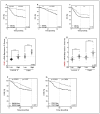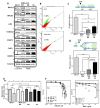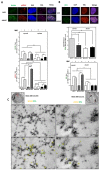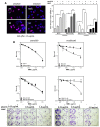Prevention of DNA Replication Stress by CHK1 Leads to Chemoresistance Despite a DNA Repair Defect in Homologous Recombination in Breast Cancer
- PMID: 31963582
- PMCID: PMC7017274
- DOI: 10.3390/cells9010238
Prevention of DNA Replication Stress by CHK1 Leads to Chemoresistance Despite a DNA Repair Defect in Homologous Recombination in Breast Cancer
Abstract
Chromosomal instability not only has a negative effect on survival in triple-negative breast cancer, but also on the well treatable subgroup of luminal A tumors. This suggests a general mechanism independent of subtypes. Increased chromosomal instability (CIN) in triple-negative breast cancer (TNBC) is attributed to a defect in the DNA repair pathway homologous recombination. Homologous recombination (HR) prevents genomic instability by repair and protection of replication. It is unclear whether genetic alterations actually lead to a repair defect or whether superior signaling pathways are of greater importance. Previous studies focused exclusively on the repair function of HR. Here, we show that the regulation of HR by the intra-S-phase damage response at the replication is of overriding importance. A damage response activated by Ataxia telangiectasia and Rad3 related-checkpoint kinase 1 (ATR-CHK1) can prevent replication stress and leads to resistance formation. CHK1 thus has a preferred role over HR in preventing replication stress in TNBC. The signaling cascade ATR-CHK1 can compensate for a double-strand break repair error and lead to resistance of HR-deficient tumors. Established methods for the identification of HR-deficient tumors for Poly(ADP-Ribose)-Polymerase 1 (PARP1) inhibitor therapies should be extended to include analysis of candidates for intra-S phase damage response.
Keywords: CHK1; CIN70 score; DNA-damage response (DDR); chromosomal instability (CIN); homologous recombination (HR); triple-negative breast cancer (TNBC).
Conflict of interest statement
The authors declare no conflicts of interest.
Figures





Similar articles
-
Prexasertib treatment induces homologous recombination deficiency and synergizes with olaparib in triple-negative breast cancer cells.Breast Cancer Res. 2019 Sep 6;21(1):104. doi: 10.1186/s13058-019-1192-2. Breast Cancer Res. 2019. PMID: 31492187 Free PMC article.
-
High levels of RAD51 perturb DNA replication elongation and cause unscheduled origin firing due to impaired CHK1 activation.Cell Cycle. 2015;14(19):3190-202. doi: 10.1080/15384101.2015.1055996. Cell Cycle. 2015. PMID: 26317153 Free PMC article.
-
Inactivation of checkpoint kinase 1 (Chk1) during parvovirus minute virus of mice (MVM) infection inhibits cellular homologous recombination repair and facilitates viral genome replication.J Virol. 2024 Dec 17;98(12):e0088924. doi: 10.1128/jvi.00889-24. Epub 2024 Nov 20. J Virol. 2024. PMID: 39565136 Free PMC article.
-
An insight into understanding the coupling between homologous recombination mediated DNA repair and chromatin remodeling mechanisms in plant genome: an update.Cell Cycle. 2021 Sep;20(18):1760-1784. doi: 10.1080/15384101.2021.1966584. Epub 2021 Aug 26. Cell Cycle. 2021. PMID: 34437813 Free PMC article. Review.
-
Participation of the ATR/CHK1 pathway in replicative stress targeted therapy of high-grade ovarian cancer.J Hematol Oncol. 2020 Apr 21;13(1):39. doi: 10.1186/s13045-020-00874-6. J Hematol Oncol. 2020. PMID: 32316968 Free PMC article. Review.
Cited by
-
Chromosome Abnormalities: New Insights into Their Clinical Significance in Cancer.Mol Ther Oncolytics. 2020 May 26;17:562-570. doi: 10.1016/j.omto.2020.05.010. eCollection 2020 Jun 26. Mol Ther Oncolytics. 2020. PMID: 32637574 Free PMC article. Review.
-
Cancer stemness-associated LINC02475 serves as a novel biomarker for diagnosis and prognosis prediction of hepatocellular carcinoma.Front Genet. 2022 Sep 2;13:991936. doi: 10.3389/fgene.2022.991936. eCollection 2022. Front Genet. 2022. PMID: 36118852 Free PMC article.
-
Targeting the DNA replication stress phenotype of KRAS mutant cancer cells.Sci Rep. 2021 Feb 11;11(1):3656. doi: 10.1038/s41598-021-83142-y. Sci Rep. 2021. PMID: 33574444 Free PMC article.
-
Exploring the ATR-CHK1 pathway in the response of doxorubicin-induced DNA damages in acute lymphoblastic leukemia cells.Cell Biol Toxicol. 2023 Jun;39(3):795-811. doi: 10.1007/s10565-021-09640-x. Epub 2021 Sep 14. Cell Biol Toxicol. 2023. PMID: 34519926 Free PMC article.
-
2020 Editor's Choice Articles in the "Cell Nuclei: Function, Transport and Receptors" Section.Cells. 2022 Aug 24;11(17):2625. doi: 10.3390/cells11172625. Cells. 2022. PMID: 36078033 Free PMC article.
References
-
- Birkbak N.J., Eklund A.C., Li Q., McClelland S.E., Endesfelder D., Tan P., Tan I.B., Richardson A.L., Szallasi Z., Swanton C. Paradoxical relationship between chromosomal instability and survival outcome in cancer. Cancer Res. 2011;71:3447–3452. doi: 10.1158/0008-5472.CAN-10-3667. - DOI - PMC - PubMed
Publication types
MeSH terms
Substances
Grants and funding
LinkOut - more resources
Full Text Sources
Research Materials
Miscellaneous

